|

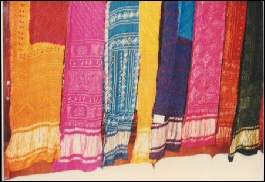 Itís a unique expression of a very time-consuming process of tying thousands of
tiny knots in a piece of fabric that has first been folded upon itself a number
of times. This is then dyed in several
stages using different colors. The knots
are pulled apart and the fabric is unfolded to reveal a repeating pattern in a
variety of hues. The process, believed
to have been used in the area for up to 5000 years, is used for Saris,
Shirts,
Shawls, Bedsheets, Curtains, Table Cloths, Bags, and other
items.
Itís a unique expression of a very time-consuming process of tying thousands of
tiny knots in a piece of fabric that has first been folded upon itself a number
of times. This is then dyed in several
stages using different colors. The knots
are pulled apart and the fabric is unfolded to reveal a repeating pattern in a
variety of hues. The process, believed
to have been used in the area for up to 5000 years, is used for Saris,
Shirts,
Shawls, Bedsheets, Curtains, Table Cloths, Bags, and other
items.
'Bandhani' (tie and
dye fabric) of Jamnagar, Mandvi and Bhuj are famous for their intricate
designs and patterns, which are used, in wedding
outfits called as 'gharchola, odhni' and sarees.
The tie-dyed
fabrics of Gujarat are perhaps the best produced in
India. Also known as 'Bandhej', it is produced on super fine
cotton 'mulmul', muslin sometimes combined with gold checks and motifs worked in
the 'jamdani' technique.
Dyeing is a
hereditary art. In the past cloth was dyed in colours extracted from trees and
flowers.
TIE N' DYE: The Proccess
The highest
intensity of Bandhini dyeing is in Kutch, but some of the best works are
from Jamnagar.
The printed portion
of the fabric are pinched and pushed into small points and then knotted with 2
or 3 twists of thread. The knotted parts remain uncoloured and the fabric is
dyed in the lightest shade first, retied and dyed in the darker colour.
The fabric may be tied and dyed several times, depending on the number
of shades in the final colour scheme. The price of the 'bandhani' depends not
only on the fabric, but also on the number of times it has to be tied and dyed
and on the intricacy of the design.
The Bandhani, tie and dye variety of
sari is a very popular women's wear. It involves an intricate process of tying
knots on the fine white fabrics, which are dipped in colours. The hues of deeper
shades are used over the previous ones to form the coloured background of the
cloth.
'Bandhani' sarees are easily available in all the bazaars and
shopping centres of Jamnagar and here you can
also find them brocaded with fine gold thread zaris.
The shops where one can buy Bandhani fabrics are Umar Ibhrahim (outside Kalavad naka) Vanza (in Darbargadh Circle), Mahavir Bandhani (Chanid Bazaar), they have extensive and beautiful collection of new and old designs
Some designs are:
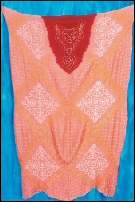 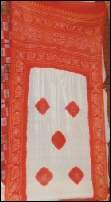 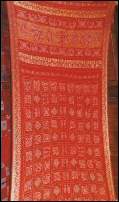 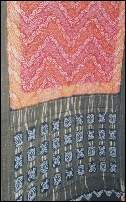 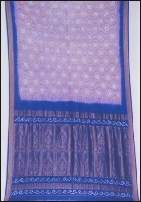
|